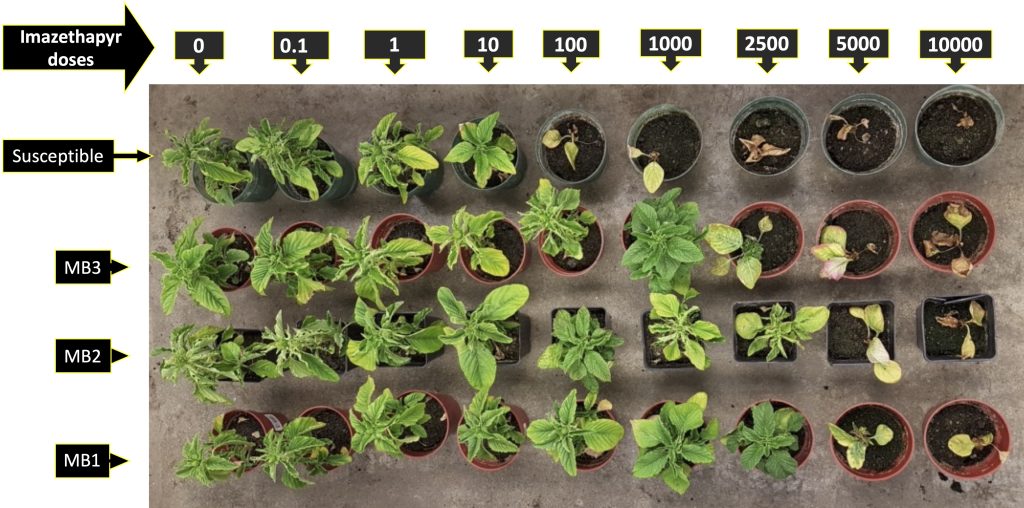
Features
Weeds
New testing tools
Researchers develop rapid molecular diagnostic tools for detecting herbicide resistant redroot pigweed populations.
June 20, 2022 By Donna Fleury
 Dose response of the resistant redroot pigweed biotypes vs a susceptible one. Photo courtesy of Sampa Saker, University of Manitoba.
Dose response of the resistant redroot pigweed biotypes vs a susceptible one. Photo courtesy of Sampa Saker, University of Manitoba. A prolific seed producer, redroot pigweed is present in high numbers in many fields in Manitoba and elsewhere across the Prairies. Recent weed surveys indicated redroot pigweed was the fifth most abundant broadleaf weed species in Manitoba. It can compete with many crops, and under hot conditions, can quickly advance beyond the recommended stages for herbicide application. Suspected populations of herbicide-resistant redroot pigweed to commonly used Group 2 Acetolactate synthase (ALS) inhibiting herbicides have been reported in Manitoba and other regions. Researchers at the University of Manitoba are working on developing rapid molecular diagnostic tools for detecting herbicide-resistant weed biotypes.
“We initiated a project to determine if these suspected populations of redroot pigweed were indeed resistant, and what they were resistant to,” explains Rob Gulden, professor of plant science at the University of Manitoba. “Our objective was to determine the level and mechanism of resistance in three redroot pigweed populations suspected to be resistant to the ALS-Inhibiting herbicides imazethapyr and thifensulfuron. Generally, the mutations that cause resistance to Group 2 herbicides are pretty well understood, however the challenge with Group 2 resistance is along with target site mutations there can also be non-target site resistance (NTSR), which is much more difficult to detect. If it is target site resistance, then we expect to be able to develop molecular markers for detection, however if it is NTSR, then rapid detection markers are much more challenging.”
In this study, three suspected resistant redroot populations were collected from the field and compared to two known susceptible populations. In the lab, a range of doses of imazethapyr and thifensulfuron were used to generate different dose response curves for each suspected population and compared to those generated for the known susceptible populations. These dose-response curves allow researchers to determine a rate of herbicide that differentiates susceptible biotypes from resistant biotypes. To determine whether or not non-target site resistance to these herbicides was also present, plants pre-treated with malathion at different doses of each herbicide were compared to those not treated with malathion.
“Our study results confirmed that all three suspected redroot pigweed populations used in our experiments were resistant to imazethapyr,” says Gulden. “However, only one population showed a low level of resistance to thiefensulfuron, so for now this chemistry should still work on two of the three resistant redroot pigweed populations. Our results confirmed that the imazethapyr and thifensulfuron resistance found in all three resistant populations is due to a common target site mutation mechanism. In one population, we also identified a target site mutation that we don’t think has been reported before in redroot pigweed, but no other mutations were identified. However, we were unable to find any non-target site resistance in any of the populations. Therefore, we expect to be able to develop molecular markers for the target site resistance, which could become very rapid detection tools to determine whether or not these mutations are present. We can use PCR tests that can provide results very quickly. If successful, then these markers could provide a rapid in-season detection tool for this particular target site resistance for suspected Group 2 resistant redroot pigweed populations.”
Once developed, these rapid detection tests would be able to assist growers with confirming whether or not a suspected herbicide-resistant redroot pigweed population has the known mutation or not. If a Group 2 ALS-inhibiting herbicide has been applied in-crop and the herbicide doesn’t seem to work, then a rapid detection test could help confirm if the herbicide failure was due to resistance or because of a technical error or weather conditions, or other factors. If the marker showing resistance is detected, producers may have time for a second herbicide application, potentially with a different mode of action to manage the resistant population. However, if the tool doesn’t detect a mutation, it doesn’t automatically mean the population isn’t resistant. These markers are specific to this resistant mechanism and won’t be able to detect resistance if a population has a different mechanism of resistance, either a different mutation or non-target site resistance.
“One of the other key tools for growers is post-herbicide application scouting, which is key to determining if the herbicide application worked or not,” adds Gulden. “Assessing that herbicide application 14-21 days later is the first opportunity to notice herbicide-resistant weeds, or rule out other factors such as a sprayer miss, a nozzle issue, or an environmental influence. Although scouting is key, it can be easy to just make the application and go on to doing other things without checking back. The problem is if you wait too long to identify an issue, weeds such as redroot pigweed can get too large very quickly and limit the ability for a second herbicide application to provide any control. Weeds like redroot pigweed can also produce a lot of small seeds that can be viable for a number of years, which is a concern, particularly if they are herbicide-resistant populations. If growers have identified herbicide-resistant redroot pigweed populations, then they will need a different long-term strategy particularly if a certain herbicide mode of action or active ingredient doesn’t work any longer. Keeping an eye on the populations and implementing management strategies including rotating herbicides and modes of action that prevent the problem from getting worse are critical.”
Now that the common mutations have been identified, the next step is developing the molecular marker primer sets and testing them. Gulden expects to be able to complete the testing this summer, and have a rapid molecular detection tool developed for detecting herbicide-resistant redroot pigweed biotypes for use in the field in 2023.